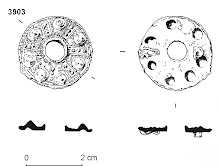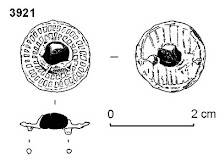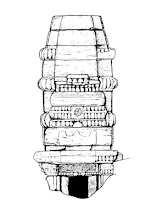Post-excavation work is well under way on the 100 Minories
excavation dataset. The last of the finds are all being washed and the samples
processed ready to go off to the specialists to prepare their reports, however
I've been busy 'sub-grouping' the contexts, which is a job that involves being
in the warm and dry. Perfect for this time of year.
| The MoLAS Archaeological Site Manual -still the definitive work for on-site recording, but what do you do with the records? |
We excavated and recorded several thousand individual
contexts on the 100 Minories site, each context a separate 'event' in the archaeological
sequence, each with a set of records and each potentially with associated
artefacts and environmental material. Understanding all these thousands of contexts
is a daunting task, so we aggregate the contexts into a series of larger
groupings, working from context level through 'Sub-groups', 'Groups' and
finally to the level of landscape 'Land-use' units like Buildings, Open Areas
and Waterfronts.
This process provides the structure behind a wider methodology
that leads you through the post-excavation process, creating larger and larger
units, working up through higher levels of understanding and interpretation, and
eventually providing the basic structure for the final publication text. The
system was developed at the Museum of London's Department of Urban Archaeology,
and is designed to fit with the Single Context Recording system described in their manual -although it
can be used for almost any logical recording system.
Subgrouping is the
first step in this process, and is where we aggregate individual contexts into
larger groupings (subgroups) based on their stratigraphic position and interpretation,
working with the context matrix. Typically there may be 2 or 3 related contexts
in a subgroup, but sometimes there is only one, and sometimes a lot more. Each
subgroup consists of a context or contexts which are immediately related to
each other and of the same date, so a subgroup might be the construction cut
for a wall, the wall itself, and the construction backfill; a mortar bedding
layer and its brick floor; or a row of posthole cuts. However the disuse backfill
of a cellar cannot be in the same sub-group as the cellar wall as it is
obviously not contemporary, this can make things tricky as generally the dating
and other specialist data is not yet ready, so sub-groups are often kept small
so we don't have to dismantle them later on.
The subgrouping process is carried out using a combination
of tools and resources, at the centre is LP Archaeology's Ark browser based database:
this contains all the context level information, as well as scanned copies of
the context sheets, and is where we enter the new sub-group details and
descriptions. Alongside this we use a QGIS project containing all the spatial
data from the site -all the digitised plans, trench edges, section lines and
other spatial elements; during sub-grouping we check all this spatial data and
use the QGIS project to interrogate the contexts spatially. Finally there is the
digital copy of the context level Harris Matrix, which is annotated with the
subgroups as they are created, and a sub-group level matrix is then created.
|
LP
Archaeology's ArkTools suite of plug-ins for QGIS allows querying, digitising,
editing and manipulation of the dataset, including the site Harris matrix
|
The team at LP Archaeology have been busy building new Open
Source tools to help in this process, building a set of tools to rapidly
digitise the context plans and sections into our QGIS project, but also tools
to check those drawings, and explore the spatial relationships between them and
link to the database which contains bespoke forms for subgrouping allowing
rapid inputting and querying.
Alongside this work we are writing a work-flow based guide describing the
sequence of tasks within the post-excavation process, using these new LP Archaeology
QGIS tools and the Ark database, to guide users through the various interlinked
tasks within a post-excavation programme. When completed this will cover post-excavation
from on-site checking and data entry through the off-site processes and initial
writing tasks; it will pick up where the MoLAS
3rd edition Archaeological Site Manual stops, and will provide a clear
structure for post-excavation work on Single Context Recording sites.














No comments:
Post a Comment